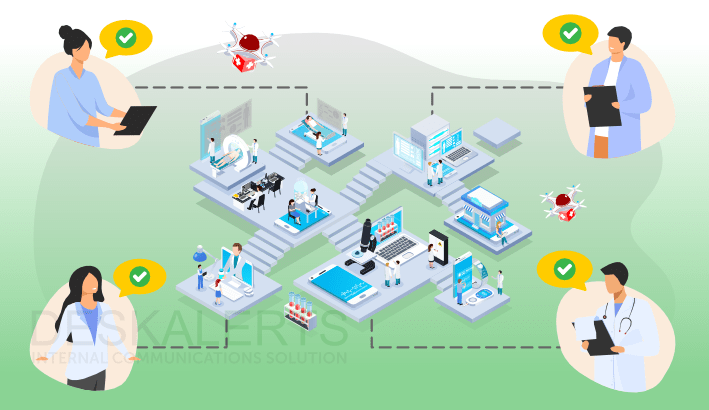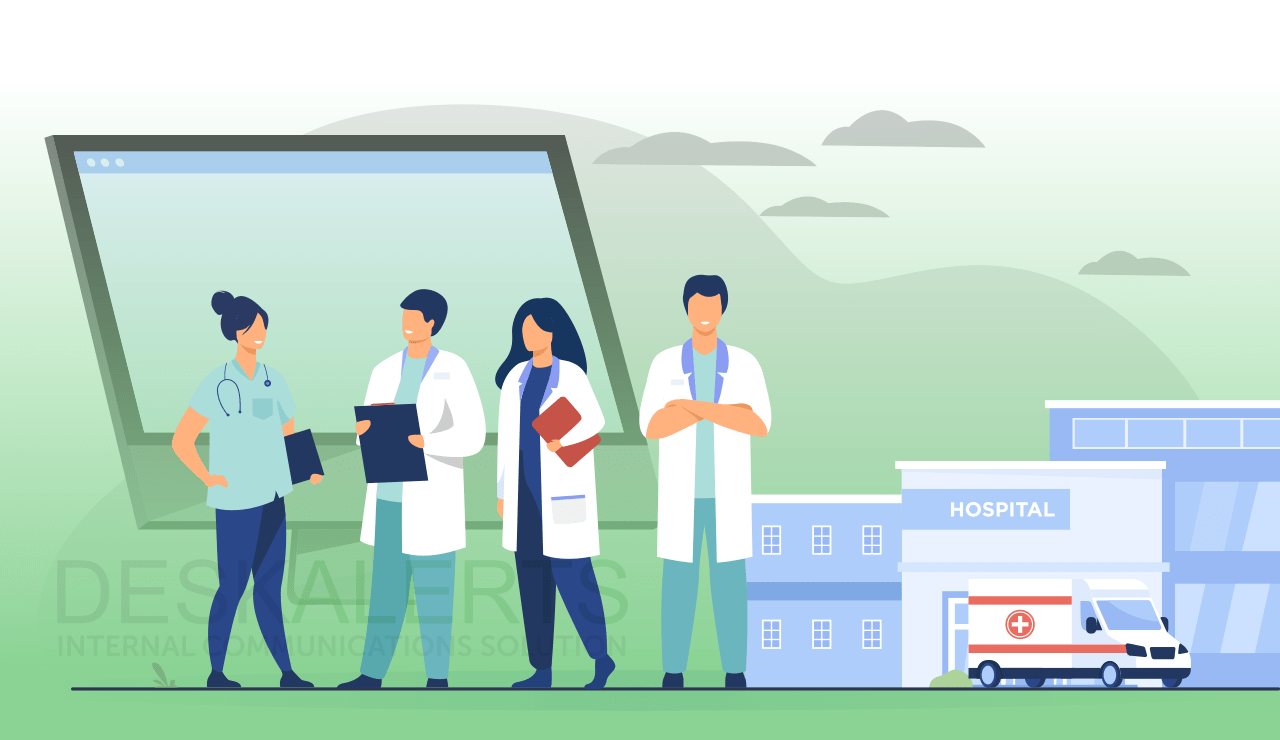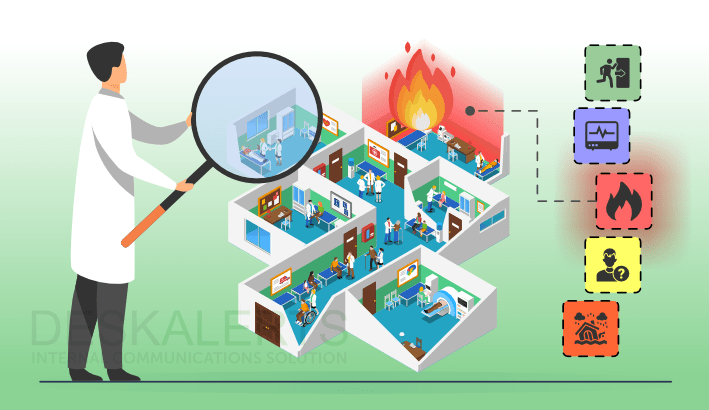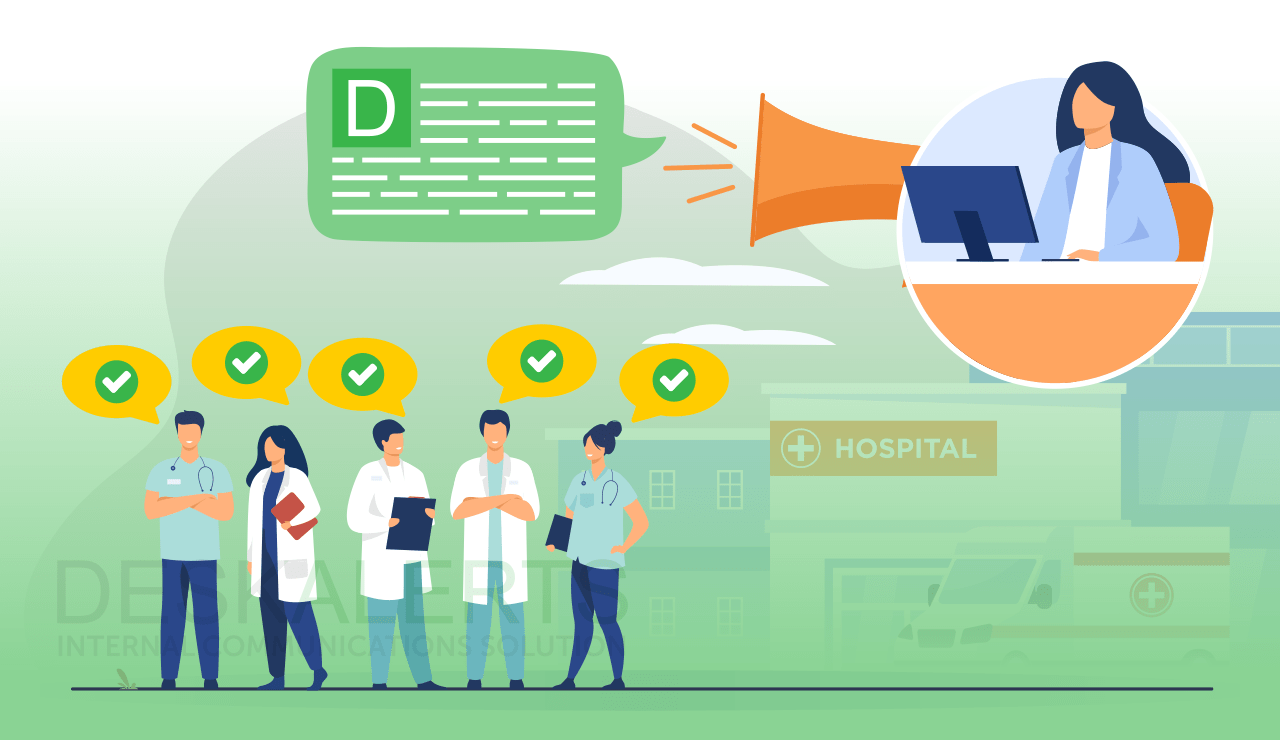
Smart hospitals, a cutting-edge fusion of healthcare and technology, have the potential to revolutionize the medical landscape. In this era of digital innovation, they represent a glimpse into the future of medical facilities.
Table of contents
What are smart hospitals?
What are the key components of a smart hospital?
What are the benefits of smart hospitals?
What are the challenges of smart hospitals?
How will smart hospitals transform the future of healthcare?
How can DeskAlerts help transform your healthcare organization into a smart hospital?
What are smart hospitals?
Smart hospitals - also known as digital hospitals, the hospital of the future, or intelligent hospitals - are healthcare institutions that integrate advanced technology and data-driven solutions to optimize patient care, enhance operational efficiency, and improve overall healthcare services.
These hospitals of tomorrow use a wide range of digital tools and devices to collect, analyze, and act on real-time data, ensuring that medical professionals can make informed decisions and provide high-quality care to patients.
What are the key components of a smart hospital?
The key components of smart hospitals include:
1. IoT (internet of things) devices.
Smart hospitals are equipped with a range of IoT devices like wearable health trackers, smart beds, and other connected medical devices. This smart technology in healthcare is used to continuously collect patient data and transmit it to healthcare providers for real-time monitoring and analysis.
2. Electronic health records (EHRs)
EHR systems play a central role in the hospital of the future by enabling healthcare providers to access patient information securely and efficiently. These digital records are intelligent hospital systems that streamline administrative tasks, reduce errors, and enhance patient safety.
3. Artificial intelligence (AI)
AI-driven algorithms are an example of smart hospital technology that’s used to analyze vast amounts of medical data and helps to diagnose diseases, predict patient outcomes and even suggest treatment plans. Machine learning algorithms can help medical professionals in the hospitals of tomorrow to make faster and more accurate decisions.
4. Telemedicine
Smart hospitals leverage telemedicine platforms to offer remote consultations and follow-up care, which enables patients to receive medical attention from the comfort of their homes. This not only improves accessibility but also reduces the burden on in-patient facilities.
5. Automated medication dispensing systems
These systems in the hospital of the future ensure the accurate and timely administration of medications to patients, reducing errors associated with manual medication processes.
6. Energy efficiency
A futuristic hospital incorporates energy-efficient technologies, such as smart lighting and heating and cooling systems to reduce energy consumption and lower operational costs.
What are the benefits of smart hospitals?
The benefits of smart hospitals include:
- Prioritized patient comfort and satisfaction through offering personalized care, reduced waiting times, and easy access to information.
- Healthcare providers are empowered by real-time data and AI-driven insights to make more accurate diagnoses and treatment decisions, leading to better patient outcomes.
- Automation and data analytics are intelligent hospital systems that streamline hospital operations, optimizing resource allocation and reducing administrative overheads.
- Healthcare costs for both patients and providers are lowered in the hospital of the future by improving efficiency, reducing errors, and minimizing waste.
- Futuristic hospitals implement robust cybersecurity measures to protect patient data, ensuring privacy and compliance with regulatory requirements.
Want to See How Smart Hospitals Communicate in Real Time?
Download our free guide 8 Real-World Use Cases: How Healthcare Teams Communicate Faster and Safer with DeskAlerts.
Discover how hospitals are already:
- Sending real-time alerts across departments
- Enhancing staff coordination and compliance
- Improving safety through targeted communication
- Supporting mobile-first, smart workflows

What are the challenges of smart hospitals?
While smart hospitals offer immense potential, they also face several challenges:
- The initial investment required to implement futuristic hospital technologies can be substantial, though long-term cost savings are often realized.
- Safeguarding patient data from cyber threats is a critical concern, even in the hospital of the future, requiring constant vigilance and investment in security measures.
- The more a hospital relies on smart technology in healthcare, the bigger the risk to its operations in the event of a serious cyber security incident. We’ve seen a lot of hospitals become victims of cyber attacks in recent years, and the sector is constantly under threat.
- Ensuring that different systems and devices can communicate and share data seamlessly remains a challenge in the healthcare industry.
How will smart hospitals transform the future of healthcare?
As the hospital of the future, smart hospitals are poised to usher in a significant transformation in the future of healthcare. Leveraging cutting-edge smart technology in healthcare and data-driven solutions, these innovative healthcare facilities will bring about several profound changes:
- The hospital of the future will prioritize patient-centric care, providing personalized treatment plans based on real-time data analysis.
- Increased use of telemedicine will benefit patients in remote or underserved areas and reduce the burden on physical healthcare facilities.
- Efficiencies will reduce healthcare costs and improve the allocation of medical staff, leading to shorter waiting times and improved patient experiences.
- The continuous monitoring of patients' health through wearable devices and remote monitoring systems will shift the focus from reactive care to preventive care. Early detection of health issues will allow for timely interventions, ultimately reducing hospital admissions.
- Patients will have greater access to their health data in the hospital of the future, allowing them to actively participate in their care decisions. This empowerment will promote better adherence to treatment plans and healthier lifestyles.
How can DeskAlerts help transform your healthcare organization into a smart hospital?
DeskAlerts is an internal communication software solution that can be effectively used as smart hospital technology to enhance communication, improve operational efficiencies, and ensure better patient care.
The system is installed on corporate devices throughout the hospital, including desktops, laptops, cellphones, tablets, and digital screens. Information is sent through a range of communication channels are used like pop-up notifications, scrolling desktop tickers, push notifications to mobile devices, corporate screensavers, SMS, digital signage, and more. The system is designed to be intrusive and disruptive so that it is guaranteed to get employees’ attention so they can act on the information they receive.
Here are some ways DeskAlerts can be used in the hospital of the future:
- DeskAlerts can be integrated with other systems
DeskAlerts is highly customizable software and can be integrated with just about any other systems you’re currently using in your hospital to send notifications to staff. This includes many IoT tools that smart hospitals are embracing. With DeskAlerts, you can streamline these communications to send to a dedicated channel.
In critical situations such as medical emergencies or security incidents, DeskAlerts can quickly send emergency alerts to all hospital staff, including doctors, nurses, and support personnel. This ensures a swift response and coordinated efforts to address the situation. You can easily customize the look of your alerts so that they align with the color code systems that exist in most hospitals.
Internal communication can be very challenging in a healthcare setting, especially when you have hundreds of employees working in different locations throughout the facility, doing different work and working different shifts. For routine communications like meeting reminders, policy updates, or shift changes, DeskAlerts can reach all staff members simultaneously, ensuring that everyone is well-informed.
- Enhance training and education
Smart hospitals often invest in continuous staff training and development. DeskAlerts can be used to notify staff about upcoming training sessions, updates to medical protocols, or new research findings. You can also send video content to staff, such as training videos via DeskAlerts. And the quizzes, polls, and surveys module can help you to quiz staff to determine their levels of knowledge retention so you can determine if further refresher training is warranted.
During times of high patient volume or emergency situations, DeskAlerts can be used to allocate resources efficiently. For example, it can notify available staff to assist in specific areas or departments that require additional support.
For security and compliance purposes, DeskAlerts can be used to communicate updates on security policies, data breaches, or regulatory changes that affect the hospital. It can be used for both awareness raising purposes and in the event of an actual cybersecurity threat to quickly alert employees to minimize the damage.
In a smart hospital, there are various digital systems in use. These will undoubtedly come unplanned outages and systems maintenance that staff need to be kept informed about. DeskAlerts can notify employees about system issues or maintenance requirements promptly, minimizing downtime and disruptions. Learn more about the role of IT departments in hospitals.
See DeskAlerts in Action Inside Leading Smart Hospitals
You’ve just read how DeskAlerts can support your smart hospital transformation. Now explore how real healthcare organizations are already using it to solve communication challenges.
Download our free guide 8 Real-World Use Cases: How Healthcare Teams Communicate Faster and Safer with DeskAlerts.
You’ll learn how to:
- Improve internal alerting systems
- Reach staff instantly — even across multiple locations
- Eliminate communication silos in large hospital settings

Incorporating DeskAlerts into the communication infrastructure of a smart hospital can significantly improve communication efficiency, reduce response times, enhance patient care, and contribute to the overall success of the healthcare facility. Get in touch with us today for a free demo of how it can help you to become the hospital of the future.
FAQ
How can we improve communication at company?
You can enhance communication in your organization by prioritizing active listening, encouraging open dialogue, and implementing digital tools for streamlined internal communication.
How communication can be improved in a large organization?
Communication in a large organization can be improved by:
- Establishing well-defined communication channels to streamline information flow.
- Ensuring leaders actively engage in two-way communication with employees.
- Implementing collaboration software for efficient sharing and retrieval of information.
How do multinational companies communicate?
Multinational companies excel in internal communication by fostering a global mindset, embracing diversity, using advanced digital tools, and emphasizing cultural sensitivity. Their strategies offer valuable lessons in promoting effective cross-border collaboration and information sharing.How can we communicate effectively in the global world?
Efficient global communication in your business involves embracing technology, cultural awareness, multilingual support, and providing staff with centralized platforms for information sharing.What are the best communication strategies?
The best internal communication strategies for a futuristict hospital involve real-time updates via digital platforms, regular staff training on technology, clear emergency communication protocols, interdepartmental collaboration, and feedback mechanisms to foster a patient-centered, efficient, and innovative healthcare environment.
 Caroline Duncan
Caroline Duncan








